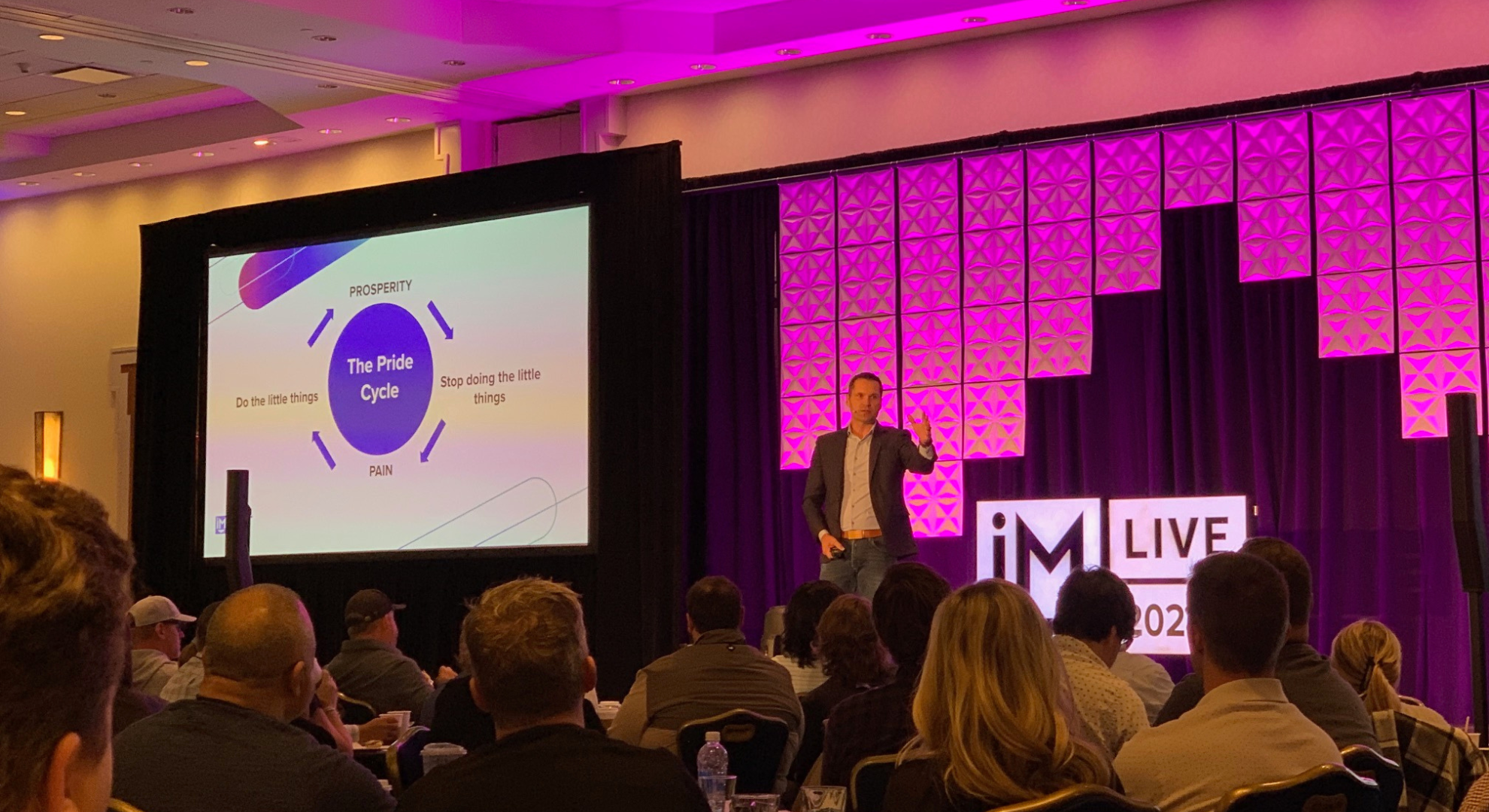7 Content Types Worth Investing In 2024 & Beyond
If you are a content or digital marketer, you are probably in need of a vacation right now. Even if you have just been on one. The last 12-18 months haven't been easy. Generative AI is eating 20-40% of your organic search traffic, attribution is becoming close to impossible, and the tactics that have always worked result in mediocre returns at best.
No, it's not only you. Across the board, organizations who were successfully using Inbound Marketing are seeing a dip. Traditional content strategies are becoming less effective. So, what types of content should you focus on to make a real impact in the coming years?
In a recent episode of the Trust Builders podcast, I shared seven content types that I believe are worth your time and resources in 2024 and beyond. The seven types of content worth investing in 2024 and beyond are:
- Primary Data Research-Based Content
- Invented Concepts
- Unique Points of View Based Content
- First-Person Narratives
- Self-Service Tools
- Big 5 Written & Video Content
- Network-Based Content
In the podcast, I go into much more detail but here is the quick run-down:
1. Primary Data Research-Based Content
Primary data research-based content is one of the most valuable assets you can create. This involves conducting original research—like surveys, questionnaires, or data analysis—to produce insights that are both unique and highly shareable.
Think of reports like HubSpot’s State of Marketing or the Databox Benchmarks; these are prime examples of content that not only attracts attention but also positions you as a thought leader in your industry.
Creating this type of content requires a significant investment of time and resources. Depending on the complexity, it could take anywhere from one to six months and cost between $2,000 to $10,000. However, the payoff is huge. Not only does it establish your brand as an authority, but it also offers endless repurposing opportunities. You can transform this data into podcasts, webinars, video series, LinkedIn carousels, and more.
Key Takeaway: Investing in primary data research can significantly boost your brand's credibility and visibility, making it a worthwhile endeavor despite the upfront costs.
- Example: HubSpot's State of Marketing Report
- Investment: 1-6 months development time, $2,000-$10,000 cost
- Pros: Unique, highly shareable, valuable insights
- Cons: Requires careful development and data expertise
- Repurposing: Podcasts, videos, webinars, infographics, social media posts
Invented Concepts
If you want to stand out as an innovator in your field, developing an invented concept—such as a framework, maturity model, or unique methodology—can be a game-changer. Examples like Gartner’s Magic Quadrant or AI Marketing Institute’s Blueprints demonstrate how powerful these tools can be.
Creating such a concept takes time—typically two to six months—and requires deep industry knowledge. It’s an investment that can range from $5,000 to $15,000, depending on the complexity and the resources required. However, once established, these concepts can be the cornerstone of your content strategy, providing a structured approach that others in the industry can adopt and reference.
Key Takeaway: An original concept can differentiate your brand, showcasing your thought leadership and providing a structured approach that others can follow.
- Example: MiaRec's Contact Center AI Maturity Model
- Investment: 2-6 months development time, $5,000-$15,000 cost
- Pros: Differentiates your brand, showcases thought leadership
- Cons: Requires deep expertise, time-consuming to develop
- Repurposing: Guides, whitepapers, educational videos, training modules
Unique Points of View Based Content
Content that reflects your unique perspective, grounded in deep expertise and experience, is another powerful way to connect with your audience. This type of content builds trust and authenticity, making your brand more relatable and credible. A great example is Rand Fishkin’s 5-Minute Whiteboard series, where he shares his insights in a simple yet impactful way.
The development time for this type of content can vary. Sometimes, it’s a quick insight that you can share immediately; other times, it might require more research and refinement. The cost is also flexible, depending on the format and production quality.
Key Takeaway: Sharing your unique insights helps build a strong connection with your audience, enhancing your credibility and trustworthiness.
- Example: Rand Fishkin's Whiteboard Friday
- Investment: Varies depending on format and production quality
- Pros: Builds trust and authenticity, positions you as an expert
- Cons: Requires deep understanding, consistency can be challenging
- Repurposing: Video series, blogs, opinion pieces, podcasts
First-Person Narratives
First-person narratives offer a compelling way to humanize your brand. By sharing personal or company stories that highlight challenges, successes, and lessons learned, you create content that is not only engaging but also relatable. Stories like Ecokit’s modular house experiment or Veed.io’s journey to their first 50k customers are prime examples.
The development time and cost for this type of content can vary widely. It could be as simple as a personal anecdote shared on social media or as complex as a documentary-style video series. The key advantage of this approach is its ability to build emotional connections with your audience.
Key Takeaway: First-person narratives allow you to share your unique story, making your brand more relatable and memorable.
- Example: Ecokit's modular house experiment
- Investment: Varies greatly depending on depth and format
- Pros: Highly engaging, relatable, humanizes your brand
- Cons: Requires vulnerability, strong storytelling skills
- Repurposing: Case studies, blogs, video series, podcasts, keynote presentations
5. Self-Service Tools
Interactive tools like self-assessments, pricing calculators, and configurators are incredibly valuable for your audience. These tools empower users to make decisions tailored to their needs, enhancing their experience and driving conversions. For instance, HubSpot’s Website Grader or Gartner’s Digital Workplace Maturity Assessment are examples of tools that provide immediate value while collecting valuable data.
Developing these tools can take anywhere from one to six months, with costs ranging from $1,000 to $50,000, depending on complexity. However, the benefits are substantial, including increased engagement, lead generation, and valuable insights into your audience’s preferences.
Key Takeaway: Self-service tools not only enhance user experience but also provide valuable data that can inform your future content strategies.
- Example: HubSpot's Website Grader
- Investment: 1-6 months development time, $1,000-$50,000 cost
- Pros: Extremely useful, encourages engagement, drives conversions
- Cons: Requires upfront investment, ongoing maintenance
- Repurposing: Lead magnet, email campaigns, website integration, webinars
6. Big 5 Written Or Video Content
The Big 5 topics—cost & price, versus & comparisons, potential problems, best of lists, and reviews—are content staples that continue to drive organic traffic and engagement. Whether in video or written form, addressing these topics helps answer the questions your audience is most concerned about, positioning you as a go-to resource.
Developing content around these topics is generally quicker and less expensive than other types. However, it requires careful research and frequent updates to remain relevant. The payoff is worth it, as this content drives SEO and positions your brand as a trusted advisor.
Key Takeaway: Continuously investing in Big 5 topics is essential for driving traffic and positioning your brand as an authority in your field.
- Example: "How Much Does Solar Energy Cost in 2024?"
- Investment: 1-3 months development time, $500-$5,000 cost
- Pros: Addresses customer questions, drives organic traffic
- Cons: Must be well-researched and unbiased, requires updates
- Repurposing: Guides, tutorials, blog posts, comparison charts
7. Network-Based Content
Network-based content leverages your connections, including interviews with customers, partners, and industry influencers. This type of content not only builds relationships but also expands your audience through the networks of those involved. Examples include interview series or expert roundtables that bring diverse perspectives to your audience.
The time to develop this content varies depending on the format, from quick interviews to more elaborate roundtable discussions. The costs also vary, but the benefits of building relationships and expanding your reach make it a worthwhile investment.
Key Takeaway: Leveraging your network to create content can enhance your credibility, foster community engagement, and provide rich, varied content for your audience.
- Example: Interview series featuring industry leaders or customer success stories.
- Investment: 2-6 months, depending on the format and number of participants.
- Cost: $3,000 - $15,000, depending on production quality and format.
- Pros: Builds relationships, expands your audience through the networks of those involved, and provides diverse perspectives.
- Cons: Coordination can be challenging, and the quality of content depends on the participants' engagement and insights.
- Repurposing: Can be transformed into blog posts, social media clips, ebooks, and even a compilation of expert advice or predictions.
- Purpose: Enhances credibility, fosters community engagement, and provides rich, varied content that appeals to a broad audience.
Investing in Content That Makes a Difference
As you plan your content strategy for 2024 and beyond, consider these seven types of content as key investments. Whether you’re conducting original research, developing an innovative concept, or sharing your unique story, each type offers distinct advantages that can help you connect with your audience, build trust, and establish your brand as a leader in your industry.
Remember, the goal is not just to create content for the sake of it but to invest in content that truly adds value—content that educates, informs, and inspires your audience. So, pick one or more of these strategies and start planning your next big content initiative. The rewards will be well worth the effort.
Share this
You May Also Like
These Related Stories

How To Write A Big 5 Comparison Article That Builds Trust

The Key to Building Trust in a Zero-Click World: Highlights from IMPACT Live

.png?width=250&height=125&name=TrustBuilderLogoWhiteTranspBackgr(250x125%20px).png)



No Comments Yet
Let us know what you think